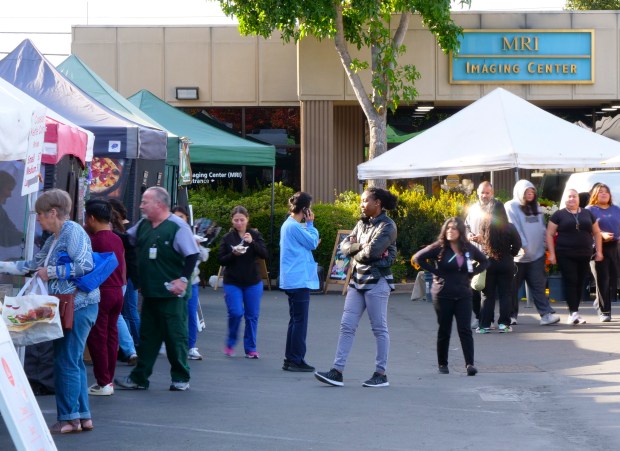Rows of fruits and vegetables in a popping array of colors greeted market goers at Salinas Valley Health on a recent Friday afternoon. November is National Diabetes Awareness Month, and the hospital has been putting together events to educate and promote healthy lifestyles.
Close to half of the adults in Monterey County are either pre-diabetic or have type-2 diabetes. “There is a huge opportunity to educate people about preventative well-being,” said Tiffany DiTullio, chief administrator officer at Salinas Valley Health who oversees community wellbeing. “If you look throughout Monterey County, more than 50% of the people in our county don’t have access to fresh fruits and vegetables. But we’re the salad bowl of the world. So, how can we fix that?”
Part of the hospital’s effort to address the health issues in Monterey County is through the Blue Zones Project, a community initiative that promotes well-being by emulating the lifestyles of centenarians around the world. One of Blue Zone’s foundational principles is to promote healthy living through the consumption of fresh food and daily physical movement.

Salinas Valley Health is partnering with Montage Health and Taylor Farms, a fresh produce business in Salinas, to sponsor community activities that promote the Blue Zones’ longevity lifestyle.
“We want people to think that the hospital is not just the place you go when you’re sick. Your hospital is a resource in the community,” said DiTullio.
“Blue Zones” is a nonscientific term that a National Geographic fellow, Dan Buettner, gave to geographical areas that house a high concentration of centenarians, or people with exceptionally long lives. Buettner traveled around the globe to unlock the secrets to longevity. His project-turned-mission became popular through the Netflix docuseries, “Live to 100: Secrets of the Blue Zones”.
In 2018, Salinas Valley Health representatives invited Sharecare, a digital health company, and Blue Zones Project to Monterey. The site visit, which included an assessment of Monterey’s residential and health infrastructure solidified potential projects that led to the launch of the Blue Zones Project in Monterey. One of the projects aims at raising an awareness of diabetes risks by increasing screening and educating the public of healthy habits.
“The whole idea of ‘why not make those (healthy) choices easier for people? by shaping the environment in which we live, is a brilliant one,” said Michael Gurven, an aging and lifespan research scientist at the University of California, Santa Barbara. “But it is not easy.”
According to Gurven, a successful initiative requires buy-in from communities at large, from local governments to grocery stores, schools, workplaces, transportation agencies, and the list goes on.
“You need to structure your environment in ways that the easiest choice might actually be the healthiest one,” he said.
What sets Blue Zones apart from other health initiatives, Gurven said, is the emphasis on community effort and changing the environment instead of putting the burden of health on the individuals.
Now, five years into the project, The Blue Zones Project Monterey County has attracted over 32,000 participants and over 120 community organizations. Blue Zones Project team hosts community activities like hikes, cooking demonstrations, beach clean-ups, gardening, and well-being workshops. Over 3,000 members have volunteered at these events.
DiTullio, who leads the Blue Zones Project in Monterey County as an executive director, runs biannual surveys to evaluate the initiative. The survey was based on a test called RealAge, a calculator of your body’s age based on different health factors. The result is an aggregate of individuals’ exercise, diet, alcohol intake and other health history compiled from over 150 self-reported survey responses.
A total of 2,221 individuals participated in the survey this year. Majority of the participants are at the age of 30 to 64. About 42% identified as white and 40% identified as Hispanic or Latino. All Blue Zones Project events in Monterey County are in English and Spanish.
The preliminary result showed that there is a significant improvement in the county’s overall well-being. The physical well-being score, which increased by 13% from 2019, is the most-improved category. Other aspects that improved include community, social, purpose, and finances.
However, there are limitations to such data.
“Self-reporting is always a little tricky for people to understand how to do,” said Elizabeth Eckstrom, a geriatric doctor at Oregon Health and Science University. “If you could visit every person in the community and ask them about each of these (survey questions), that’s going to be ideal,” she said. “But that’s tricky and takes a lot of time and money.”
Nevertheless, Eckstrom believed that the medical evidence is strong for the effectiveness of the Blue Zones project. “There are communities who have done it successfully,” she said. One of these communities was Albert Lea, Minnesota, where the foot traffic and daily exercise has increased considerably by adding sidewalks, bike lanes, and public spaces. “The Blue Zones Project really was able to make giant changes in their community,” she said.
Monterey County is the 48th community to adopt the Blue Zones project. David Weiss, a former physician at NCH Healthcare System and current chief medical officer at Blue Zones Project, started the Blue Zones Project in Naples in 2015 after seeing many of his patients repeatedly return to the hospital with the same disease. Weiss was present at Monterey when they started the project.
“We’re going nowhere, we’re not going to be changing anything. So, I started to look for a way to keep people better and not get sick in the beginning,” he said. By 2017 it was apparent that the project was reaping progress. The health care cost went down by almost 50% that year. “The result was remarkable,” he said.
According to Weiss, the results come from people starting to exercise, eat healthfully and realize what their purposes are.
The Blue Zones principle, dubbed the “Power 9,” is a combination of nine characteristics of centenarians’ lifestyle, which include: moving naturally, having a life purpose, a red,uced stress level, eating only until 80% full, consuming more plant-based food, drinking alcohol moderately, being a part of a faith-based community, putting loved ones first, and having a social circle. Buettner published this observation in the American Journal of Lifestyle Medicine in 2016.
“When you look at the nine principles, there’s nothing unusual about it,” said Weiss.
What is different about the Blue Zones Project, is that it’s organized, and it’s metrically driven, said Weiss. “If I say I want to improve my golf game, but I’m not keeping score, it doesn’t work so well,” he said.
Jane Calbreath, a resident of Aptos, who binge-watched the Blue Zones Netflix series, and has experienced living in Okinawa, a Blue Zone region in Japan, noticed a few things that stood out about the community there. “People live close to the land; their daily life is physical activity, and their food is all made from scratch,” she said. “In the little towns, people are joined together to do things and help one another.”
Instead of focusing on the metrics, Calbreath focused on changes she could experience herself. “To me, the mindset is what is important,” she said, “I am my own evidence.” Now in her early 70s, Calbreath is looking to form a Blue Zones community group in Aptos to promote well-being.
To raise awareness of diabetes this month, the Blue Zones Project Monterey County has organized events such as ‘Walk with a Doc’ where people can hike and ask a doctor about diabetes, “El Susto” documentary screening on sugary drinks, and cooking demonstrations that encourage the use of fresh ingredients. They will also be launching the Double Up Food Bucks program, in partnership with Aspire Health, to provide low-income residents and CalFresh customers with a 50% discount on California-grown produce, up to $15 per day.
The Blue Zones Project in Monterey County will continue through 2025. After which, the team will consider sustainable paths forward.
“A healthy community should rely less on the four walls of a (hospital) building,” said DiTullio, “and rely more on their opportunity to really make healthful choices for themselves.”








